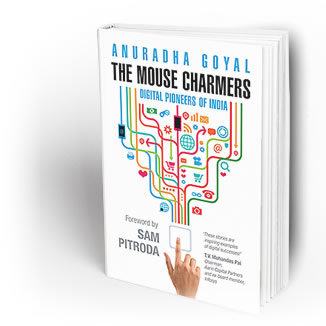With the advent of Internet, a new breed of entrepreneurs have come up who used the power of Internet to make shopping, reading awesome content and connecting to anyone with just a click.
The book The Mouse Charmers authored by Anuradha Goyal looks at first generation Indian Entrepreneurs, who have disrupted various domains and established their authority. In this book, Anuradha takes us through the journey of 12 entrepreneurs across 3 categories – commerce, content and connectors.
For each startup, the information provided is a mix of information scoured from various online sources and interviews with the founders. Each story has been neatly divided into conceptualization, business model, behind the scenes steps for getting the model work, technology spread of the company, and the out-of-the-box ideas deployed by digital entrepreneurs to get the much needed traction in early days. Interestingly, any topics related to fund raising has not been discussed in the book.
For the Content Section of the book – Anuradha has featured Zomato, Games2Win, ImagesBazaar and Chai with Lakshmi online talk show. While the first 3 entrepreneurs have atleast 6-7 years of experience in running the show, Chai with Lakshmi is relatively new and is 2+ years into operation.
The author explains to us the difference between traditional and digital content, and how the entire chain from content creation, distribution and marketing has transferred to the content creators. Alok Kejriwal’s story has some great insights such as Games2Win blog documenting all the experiments conducted during the journey, including all that failed. Anuradha dissects Chai with Lakshmi model, and feels that the entrepreneur could do a better job at technology.
For the connectors section of the book – Anuradha has featured Shaadi.com, CommonFloor.com, Indiblogger and Rang De. Each of them are powerful connectors and fulfill a need for people who come searching for information online. Although CommonFloor.com did get the most detailed explanation, the book quickly explains us the business models of all the companies. One common pattern among all these connecting platforms is the effective leveraging on Social Media and offline events. To date, effective offline marketing is one of the key drivers to the online portals. It goes without saying for all the other stories not featured in the book too – although lot of people are online, strong word of mouth and buzz is generated through offline events. Lot of emphasis has been placed on the business model, and revenue generation mechanisms. The challenges these connectors faced, along with the issues they encountered while scaling up have not been discussed in detail. Reading this section gives us a fair idea of the revenue generation mechanisms that can be adopted for a successful connector digital company.
This section has some typos, which did distract me from reading continuously.
The startups covered in the commerce section are very diverse – flipkart, make my trip, caratlane and bigbasket.com. As she dissects through the flipkart model, she explains about the nature of experimentation at the startup, and it is one of the reasons for it’s huge success. For makemytrip, she takes us through the various features that keep it ahead, such as route planner, SMS-based bus ticketing and innovative features such as ‘Easy Pay’. MakeMyTrip has a lot of offline activity, and has opened stores in more than 50 cities across the country with a mix of 18 company owed and 40 franchisee stores.
She gives a brief mention to redBus and BookMyShow.com along with the other startups discussed in detail. BigBasket.com is one of the well elaborated sections of the book, and the reader gets a firsthand account of how difficult is it to do the online grocery business. The founding team has vast experience in managing offline grocery business, had good capital to begin with and has used technology very wisely in their operations.
Anuradha then goes on to explore what it takes to sell high value items like diamonds online. Like in bigbasket, the founders are a great mix of domain knowledge and technological expertise. Similar to makemytrip, caratlane has also gone the offline way by setting up experience lounges and providing sets to home for trial before purchase. She also explains how CaratLane is able to provide diamonds at 25 percent lesser than the market rate.
There are couple of notable takeaways from the book –
a) For a strong online business to flourish, technology is one of the most important pillars and is best kept in-house. The team understands the business intentions and has a quick turn around time for implementing new changes on the fly. Also, A/B experimentation is feasible only with an in-house team.
b) Although all the businesses mentioned are online, most of them have done promotions offline. So, decent mix of offline promotions with online is a better way to spend your marketing dollars.
c) Most of the startups mentioned in the book are the early adopters of that domain. And they did put in effort to reach to the top in that domain, and stay there. This is a subtle inference that there cannot be many players in the same domain online – it’s better to pick a greenfield for your dominance.
d) Bangalore is the chosen destination for startups because of the huge available tech talent, mentoring and a general acceptance for entrepreneurs.
e) Piggyback entrepreneurship works, and has been successfully leveraged by the entrepreneurs mentioned in the book
The book is a good read for someone who wants to understand how these digital companies work. It does not offer any personal insights or struggles from the founders. So, if the readers start off with this expectation – it is a onetime good read.





